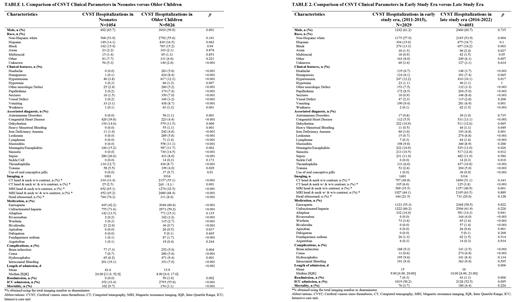Introduction:
Pediatric Cerebral Venous Sinus Thrombosis (CVST) poses risks of neurological sequelae and mortality, necessitating timely diagnosis and appropriate antithrombotic therapy. Limited sample sizes in previous studies have led to inconsistent treatment recommendations. To better understand pediatric CVST, we used the Pediatric Health Information System (PHIS) database to compare clinical features, treatment practices, and outcomes in neonates versus older children, and in different time periods, to analyze the influence of various parameters on healthcare outcomes.
Methods:
Deidentified, retrospective data of pediatric CVST was extracted from the large multi-center PHIS administrative database from January 1, 2011, to October 1, 2022. Diagnostic, imaging, procedure, and pharmaceutical billing codes were used to identify demographic information, clinical characteristics, management, and outcome. Multivariance analysis was performed on study parameters in neonates vs. older children (Table 1) and early (2011-2015) vs. late (2016-2022) study era (Table 2).
Results:
6080 hospitalizations with CVST diagnosis (0.1% of all hospitalizations) were identified (61% male; median age 5 years; range 0-17 years). Median hospital stay was 8 days (IQR 4, 22), with 52% (N=3147) admitted to the intensive care unit (ICU). Overall mortality of all children was 4.2%.
Neonates constituted 17.3% of the hospitalizations (N=1,054). Clinical features in neonates were less-often reported vs. older children more often had headache, hypertension, vomiting, papilledema and hemiparesis (p<0.001). Congenital heart disease/sepsis were common associated diagnoses in neonates vs. sinusitis/mastoiditis in older children (p<0.001). Neonates had a longer hospital stay (median 24 (IQR 11, 55), vs. 8 days (IQR 4, 17); p <0.001), but lower ICU admission (33.4% vs. 55.6%; p<0.001) and readmission rate (0% vs. 1.0%; p=0.002) when compared to older children. CT without contrast was used less often (33.4% vs. 55.1%; p < 0.001), and head ultrasound more often (76.3% vs. 8.0%; p < 0.001) for neonates vs. older children. Enoxaparin and unfractionated heparin (UFH) remained the primary treatments for CVST, with UFH utilized more often in neonates (71.6% vs. 59.2%; p<0.001). Direct oral anticoagulants (DOACs) were predominantly used in older children in limited numbers. Coma and hydrocephalus as complications were lower (0.7% vs. 5.6%, p<0.001 and 6.2% vs. 9.4%, p=0.001), and intracranial bleeding was (19.1% vs.7.0%, p<0.001) in neonates vs. older children. Neonates had increased mortality rate compared to older children (9.7% vs. 3.1%; p<0.001).
The number of CVST admissions increased in the late (2016-2022) compared to the early study era (2011-2015) (0.11% vs. 0.08% of all admissions, p<0.001). Patient demographics, duration of hospital stay, ICU admission rates, clinical features, and imaging modalities remained similar in both groups. The use of bivalirudin, and DOACs was present in the late vs. none in the early era (p<0.001 except Dabigatran). Coma in the late (p<0.001) and brain infarct in the early study era (p<0.001) were more common complications. Both readmission rate (p=0.006) and hospital stay (p=0.006) were slightly higher in the late era. No statistically significant differences were found in mortality rate between the two eras (p= 0.226).
Conclusion:
Pediatric CVST is a serious disorder, with an overall mortality rate of 4.2% in our study. Neonates had distinct clinical features, associated diagnoses, and complications compared to older children. Predominantly UFH and rarely DOACs were administered in neonates. Neonates experienced longer hospital stay, and statistically significant higher mortality rate when compared to older children, consistent with prior studies. Newer anticoagulants were utilized increasingly in the late vs. early study era. Though readmission rate and hospital stay increased in the late era (not statistically significant), this did not translate into increased mortality. Increasing rate of hospitalizations in late compared to early study era is likely due to increasing medical complexity/technological advances in diagnosis/management of pediatric CVST. Future multi-center, prospective studies are needed to better address the increased neonatal mortality and improve overall care of pediatric CVST which is increasingly prevalent as seen in our study.
Disclosures
No relevant conflicts of interest to declare.


This feature is available to Subscribers Only
Sign In or Create an Account Close Modal